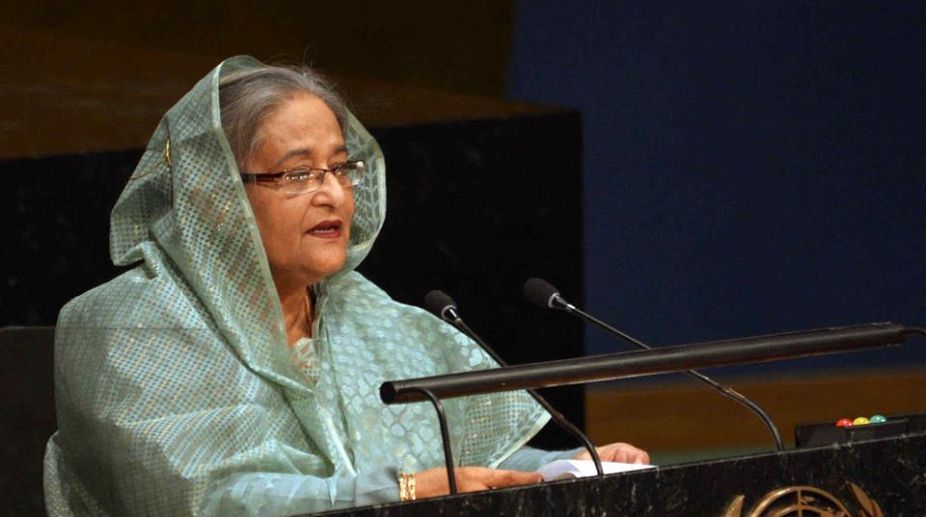Sheikh Hasina sworn-in as Bangladesh PM for 4th straight term
Bangladesh President Mohammed Shahabuddin administered the oath of office and secrecy to Hasina, 76, at a programme in which several other high ranking officials were also present.

Bangladesh Prime Minister Sheikh Hasina (Photo: Facebook)
Bangladesh watchers were euphoric after the much hyped and publicised India visit (April 7-10) of Prime Minister Sheikh Hasina raising perhaps misplaced hopes that she would strengthen her secular credentials upon return.
Intriguingly, however, the secular forces in Bangladesh have been deeply disappointed by Hasina’s recent statements which could be seen as warming up to the Islamic hardliners, clearly departing from her secular stance.
The issue emanated from the statue of a Greek goddess, Themis (Greek goddess of justice) installed inside the Supreme Court at Dhaka becoming an eyesore to Islamic hardliners who went on a campaign demanding removal of the idol as it wore a saree which was considered opposed to the tenets of Islam.
Advertisement
The vitriolic campaign was spearheaded by none other than Hefazat-eIslam, an extreme Islamic hardline outfit which has registered a robust growth contributing to reinforcement of fundamentalism in Bangladesh.
Reverting to Hasina’s body language, it is more than an extraordinary coincidence that these gestures became apparent within only 48 hours of her return from India, especially when progressives in Bangladesh had earlier felt that apart from inking numerous bilateral treaties, the Indian polity must have subtly put across to her to be more firm in dealing with Islamic extremists constantly perpetrating excesses on minorities, foreigners and liberals .
On April 11, while addressing Supreme Court judges in Dhaka, Hasina said, “I don’t like it myself it being called a Greek statue and how did a Greek statue reach here?”
This statement has shocked many. Secular and forward thinking lobbies in Bangladesh are crestfallen by Hasina’s tenor.
They apprehend that emboldened by her “pro-Islamic” rhetoric, anti liberation forces may start demanding removal of statues and memorials erected in memory of the 1971 liberation war.
Prominent crusader of secularism in Bangladesh, Shahriar Kabir has already criticised Hasina for what he described as her U-turn. Elaborating on the development, litterateur Taslima Nasreen has questioned the hardliners saying that it’s Greece and only Greece which has given civilisation and the statue is a symbol of Greek culture.
She has said that any move to remove the statue would be a clearly regressive step. Hasina did not stop here.
On a different occasion but in the same vein, she stated that her government would soon start recognising degrees obtained from hardline madrasas thus paving the way for millions of religious scholars to qualify for jobs in public and private sectors.
If implemented (and it looks very likely) in the not so distant future, Bangladesh may have theocratic elements embedded in all walks of life.
And precisely because of this, seculars appear alarmed and apprehend that Hasina is trying to reach out to hardliners – to befriend them to be on her right side as the dates of the next general elections draw close.
Even if we assume such gestures are for electoral reasons, Hasina should keep an exit route open. The radicals wouldn’t let her escape without fulfilling her promises.
The Jamat-e-Islami is banned but its cadres are around following the party ideology in letter and spirit. Jamat and Hefazat-eIslam may have different names but they remain steadfastly united in pursuit of their goal to make Bangladesh an Islamic state.
Politically and diplomatically therefore, Hasina should be astute enough to wean one away from the other lest her own political existence is imperilled.
Hasina will play with fire if she continues to come closer to Hefazat-e-Islam. The group has shown a tremendous rise within only seven years. Its cadres have increased manifold. Its agenda is loud and clear.
It wants enactment of blasphemy laws including banning of Ahmediyas as an Islamic sect.
Its 13-point charter still holds good and it had already demonstrated its scheme of things in 2013 through a long march exposing its strength and drawing more popular support. One should not forget that such outfits are linked to terror.
Bangladesh is already under the ISIS scanner and witnessed a series of terror attacks full of fury and devastation.
Many youth stand radicalised and we don’t know how many are fighting with the ISIS rank and file.
After the collapse of ISIS, the cadres will be back in Bangladesh adding muscle to the ultras. The most dreaded home grown terror outfit, JMB took off with cadres who had participated in the Taliban-led war in Afghanistan.
That’s a lesson to be borne in mind . Those at the helm in Dhaka must exercise extreme discretion and keep bodies like Hefazat-e-Islam at a distance so that her party does not collaborate with it.
This is vital in the interest of peace and stability in the region .
The writer is a retired IPS officer and a security analyst. He is also a senior fellow of the India Police Foundation. The views expressed are personal.
Advertisement